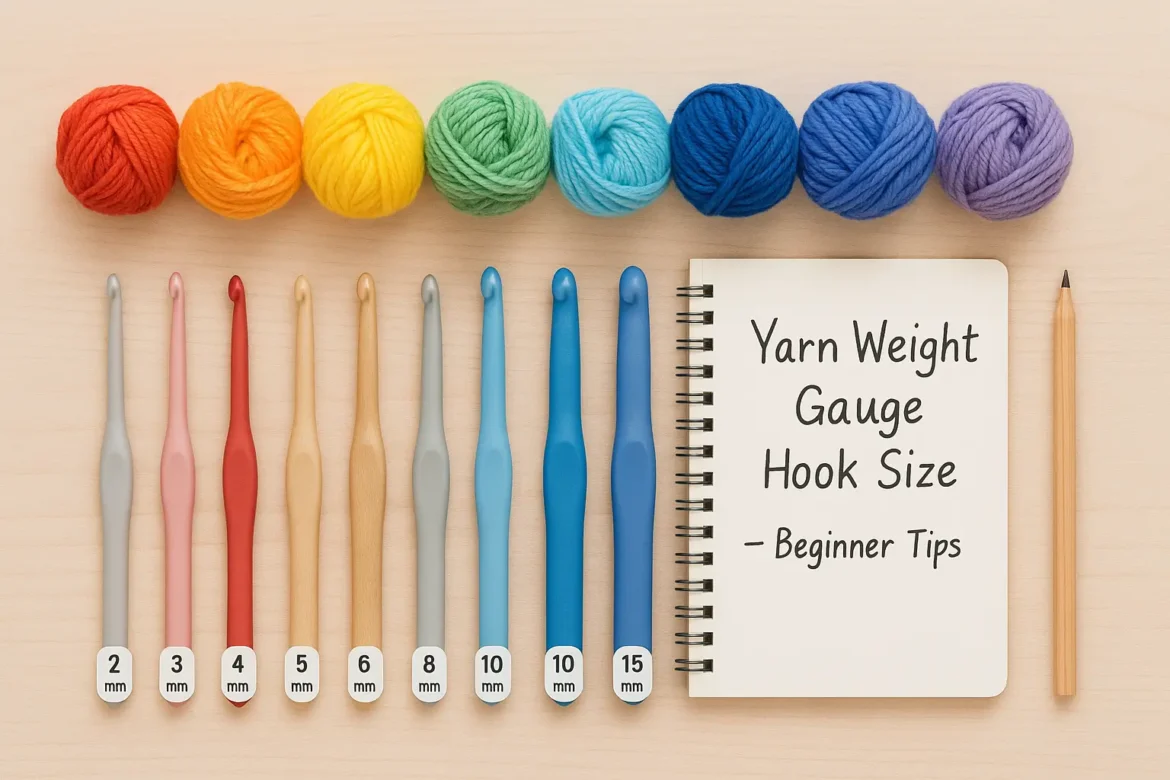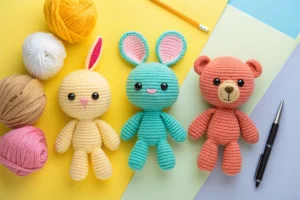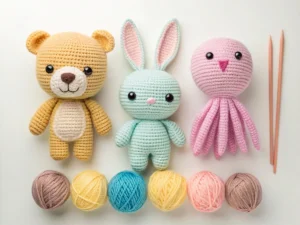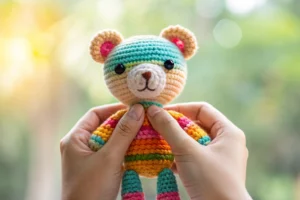Introduction: Mastering Yarn Weight Gauge and Hook Size as a Beginner
Are you confused by yarn weight gauge hook size when starting a crochet or amigurumi project? When starting any crochet or knitting project, understanding yarn weight gauge hook size is one of the most important things every beginner must learn. These three factors work together to determine the overall look, feel, size, and stretch of your final piece—whether it’s a cozy scarf, a snug hat, or a tiny amigurumi creature.
Many new crafters struggle with projects turning out too big, too tight, or simply “off”—and most of the time, it’s due to not choosing the right yarn weight, gauge, or hook size. But don’t worry—this guide breaks it all down in simple terms so you can confidently match your materials and achieve the perfect result every time.
Let’s demystify yarn weight, gauge, and hook sizes and get you stitching like a pro! 🎯🧵
Jump to a section
What Is Yarn Weight?
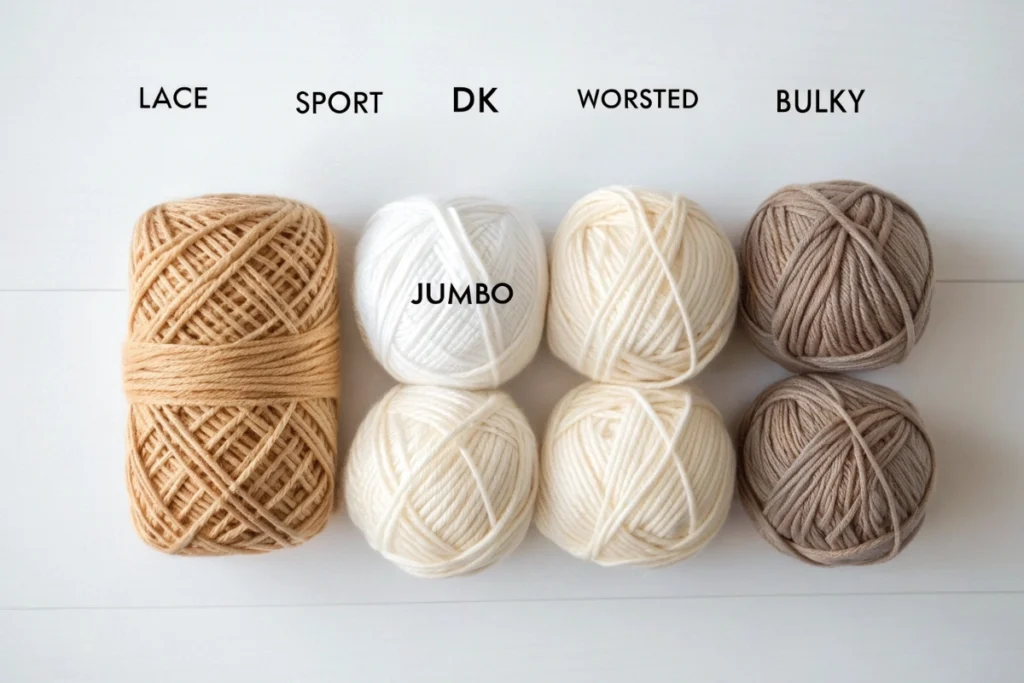
Yarn weight refers to how thick or thin a yarn strand is, not how heavy it is! It plays a major role in the final look and feel of your crochet or knitting project. Yarn weight categories range from lace weight (very fine) to jumbo (extra thick), and each one affects the gauge and the recommended hook size.
The Craft Yarn Council has established a widely accepted standard yarn weight system that most designers and yarn manufacturers follow. This resource is especially helpful for beginners trying to match the right yarn weight to a specific project.
Using the wrong yarn weight for a pattern can lead to mismatched sizes and disappointment. That’s why understanding yarn weight gauge hook size is key to crafting success.
Common Yarn Weights:
| Yarn Weight | Symbol | Common Uses |
|---|---|---|
| Lace | 0 | Doilies, lacy shawls |
| Super Fine | 1 | Lightweight socks, baby wear |
| Fine | 2 | Light scarves, summer tops |
| Light (DK) | 3 | Hats, garments |
| Medium (Worsted) | 4 | Sweaters, amigurumi |
| Bulky | 5 | Thick scarves, blankets |
| Super Bulky | 6 | Chunky sweaters |
| Jumbo | 7 | Rugs, statement pieces |
When choosing yarn for your project, always check the pattern’s yarn weight recommendation and match it accordingly.
What Is Gauge and Why Does It Matter?
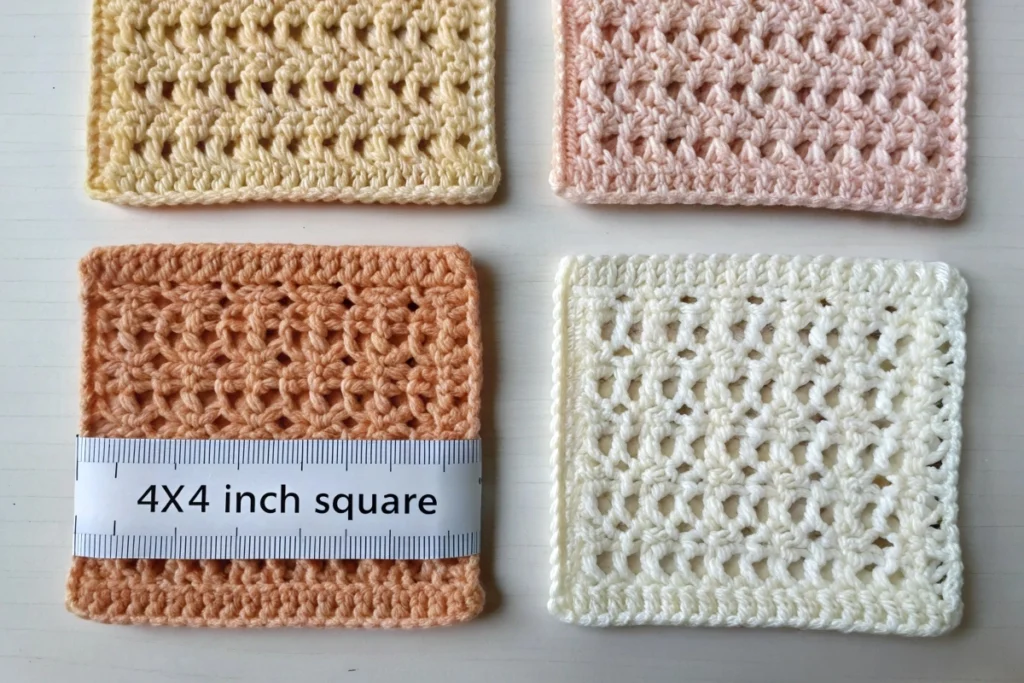
Gauge is the number of stitches and rows you create in a measured area—typically a 4×4 inch (10×10 cm) square. It ensures that your finished project matches the size and proportions intended by the pattern designer.
Gauge is directly affected by yarn weight, gauge, and hook size, which all work together as a trio. If any one of these factors changes—say, you switch yarn weight or use a larger hook—your gauge will change, too.
Matching the yarn weight gauge hook size combo recommended in a pattern is essential for accurate results. If your gauge is off, your project might turn out too tight, too loose, or completely misshapen.
For example, if a pattern calls for a worsted-weight yarn and a 5 mm hook, but you use bulky yarn with the same hook, your stitches will be larger, affecting both gauge and texture.
💡 Pro Tip: Always make a gauge swatch before starting your project. If your stitches are too small, try using a larger hook; if they’re too large, switch to a smaller hook. This helps you achieve the right balance between yarn weight, gauge, and hook size.
Understanding the relationship between yarn weight gauge hook size is key to creating consistent, professional-looking crochet projects, even as a beginner.
How to Choose the Right Crochet Hook Size
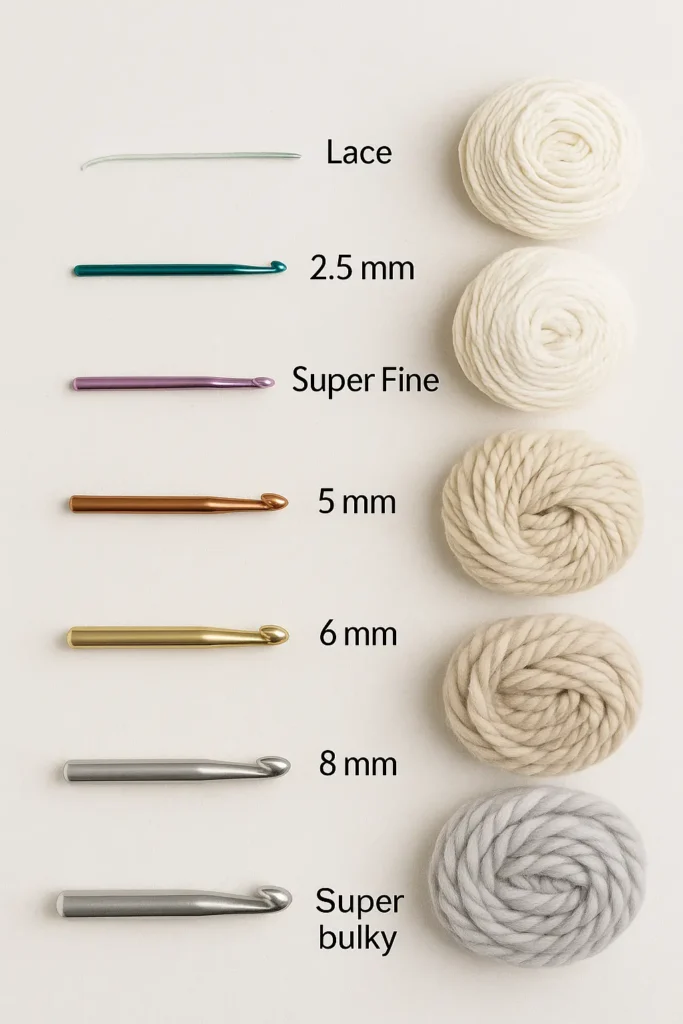
Choosing the right crochet hook size is just as important as selecting the correct yarn. The yarn weight. Choosing the right crochet hook size is just as important as selecting the correct yarn. The yarn weight gauge hook size combination is crucial for achieving the proper tension, stitch definition, and structure in your crochet project.
Each yarn label typically suggests a recommended hook size based on the yarn’s weight. For example, worsted-weight yarn usually works best with a 5.0 mm (H-8) crochet hook, while lace-weight yarn might require a much smaller 1.75 mm steel hook. This information helps you match your yarn weight gauge hook size trio effectively.
But keep in mind your individual tension (how tight or loose you crochet) also plays a big role. Even with the right hook and yarn, your stitches might not match the pattern’s intended gauge without adjustments.
🎯 Tips for Picking the Right Hook Size:
- Check the yarn label: Look for the recommended yarn weight, gauge, and hook size.
- Read your pattern carefully: Some designs need tighter stitches for shaping or looser ones for drape.
- Swatch first: Always crochet a small test square to verify that your stitch and row count match the gauge.
- Adjust accordingly: If your swatch is too loose, go down a hook size. If it’s too tight, go up.
Ultimately, choosing the correct yarn weight gauge hook size helps ensure your finished item turns out as intended, whether it’s an amigurumi plushie or a delicate shawl.
Crochet Hook Size Chart Based on Yarn Weight
📊 Quick Reference Chart
Matching the right yarn weight gauge hook size combination is essential for producing well-structured crochet projects. The crochet hook size you choose directly impacts your gauge, which determines the final dimensions, texture, and overall success of your piece. Whether you’re crocheting lace doilies or plush blankets, having a reliable reference chart makes a huge difference—especially for beginners.
Visual Chart for Beginners
Here’s a simplified image that provides a quick overview of recommended hook sizes for each yarn weight category:
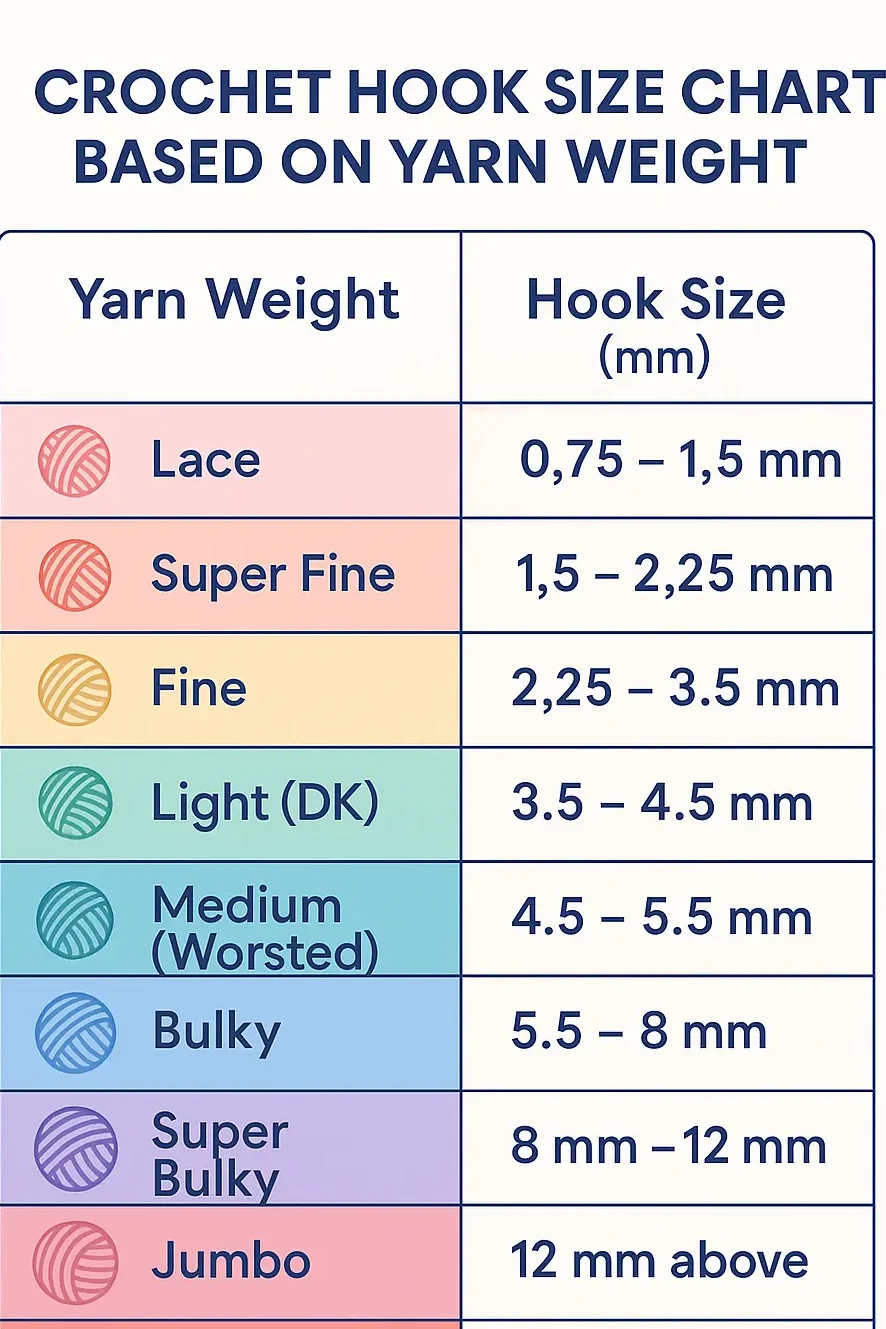
✅ Note: This image offers a beginner-friendly snapshot of how yarn weight gauge hook size match up. It’s great for quick reference while working on a project.
📐 Detailed Crochet Hook Size Table by Yarn Weight
While the visual chart is helpful, it’s also important to use a complete chart based on industry standards—like those from the Craft Yarn Council. This ensures your stitches match the pattern gauge exactly and helps prevent sizing issues.
| Yarn Weight | Weight Symbol | Recommended Hook Size (US) | Recommended Hook Size (mm) | Common Projects |
|---|---|---|---|---|
| Lace | 0 | B-1 to E-4 | 2.25 – 3.5 mm | Doilies, lace shawls |
| Super Fine (Sock) | 1 | B-1 to E-4 | 2.25 – 3.5 mm | Baby items, socks |
| Fine (Sport) | 2 | E-4 to 7 | 3.5 – 4.5 mm | Light scarves, garments |
| Light (DK) | 3 | 7 to I-9 | 4.5 – 5.5 mm | Hats, tops, amigurumi |
| Medium (Worsted) | 4 | I-9 to K-10.5 | 5.5 – 6.5 mm | Blankets, sweaters, toys |
| Bulky | 5 | K-10.5 to M-13 | 6.5 – 9 mm | Thick scarves, throws |
| Super Bulky | 6 | M-13 to Q | 9 – 15 mm | Oversized sweaters, floor cushions |
| Jumbo | 7 | Q and up | 15 mm and up | Rugs, chunky statement pieces |
💡 Why this matters: Using the correct yarn weight gauge hook size combo helps you maintain proper stitch tension and match your project’s intended size and drape.
❓ Why Charts May Differ
Some visual guides (like the one above) show narrower hook ranges for clarity and simplicity. However, official industry standards provide broader ranges to account for different brands, materials, and individual tension.
✨ Pro Tip: Always make a gauge swatch before starting your project—even if you follow the chart—to ensure your stitches match the pattern’s intended measurements.
🧶 Why This Chart Matters
If you’re aiming for a professional-looking finish, getting the yarn weight gauge hook size combination right is non-negotiable. This trio influences how dense or drapey your fabric feels, the accuracy of your stitch counts, and how your project shapes up overall.
💡 Pro Tip: Don’t rely on hook size alone—check the yarn label, make a gauge swatch, and always consider how your chosen yarn weight gauge hook size combo affects the finished result.
By keeping this chart nearby and practicing with different yarns, you’ll gain confidence in selecting the ideal yarn weight gauge hook size combination for every project.
Why Hook Size Affects Your Crochet Project
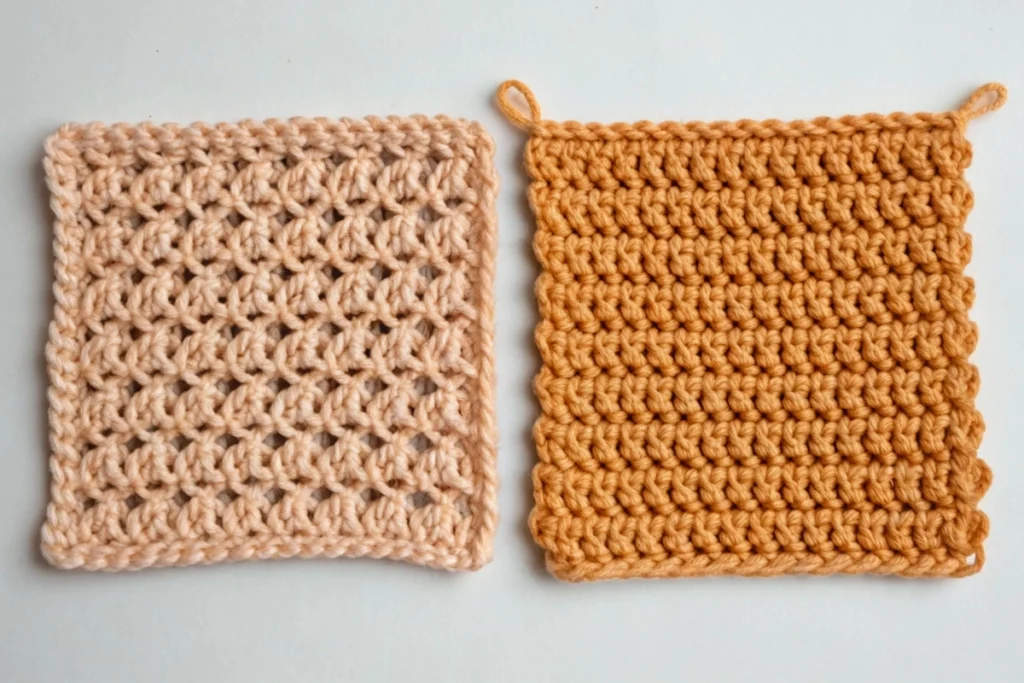
When it comes to crochet, your choice of yarn weight gauge hook size doesn’t just influence the size of your project—it can completely change its look, feel, and function.
Using a larger hook than recommended for your yarn weight can create looser, airier stitches. This is ideal for shawls or garments where drape and flow are important. On the other hand, using a smaller hook results in tighter stitches, which are perfect for items like amigurumi that need firmness and shape retention.
For example, pairing a bulky yarn with a small hook will make your fabric stiff and difficult to work with, while using a lace-weight yarn with a large hook may result in a floppy and uneven texture. That’s why matching your yarn weight gauge hook size combination is so essential for project success.
🧵 Here’s How Hook Size Impacts Your Crochet:
- Tension and Flexibility: A smaller hook tightens your stitches, creating a firm, dense fabric. Great for amigurumi or items needing structure.
- Drape and Flow: A larger hook loosens your stitches, producing soft, flowing textures ideal for shawls or lightweight scarves.
- Size Accuracy: Deviating from the pattern’s recommended hook size can cause your finished piece to be too small or too large.
- Texture and Appearance: The hook size alters stitch definition. Bigger hooks give a more open, airy look; smaller hooks give clean, tight stitches.
💡 Pro Tip: Always refer to the recommended hook size on the yarn label or pattern. Then, test it with a small swatch. If your gauge doesn’t match the pattern, adjust your hook accordingly.
By understanding how yarn weight gauge hook size work together, you gain control over your crochet outcome and avoid the frustration of frogging an entire project because the fit or texture feels off.
Yarn Labels Explained: How to Read Them
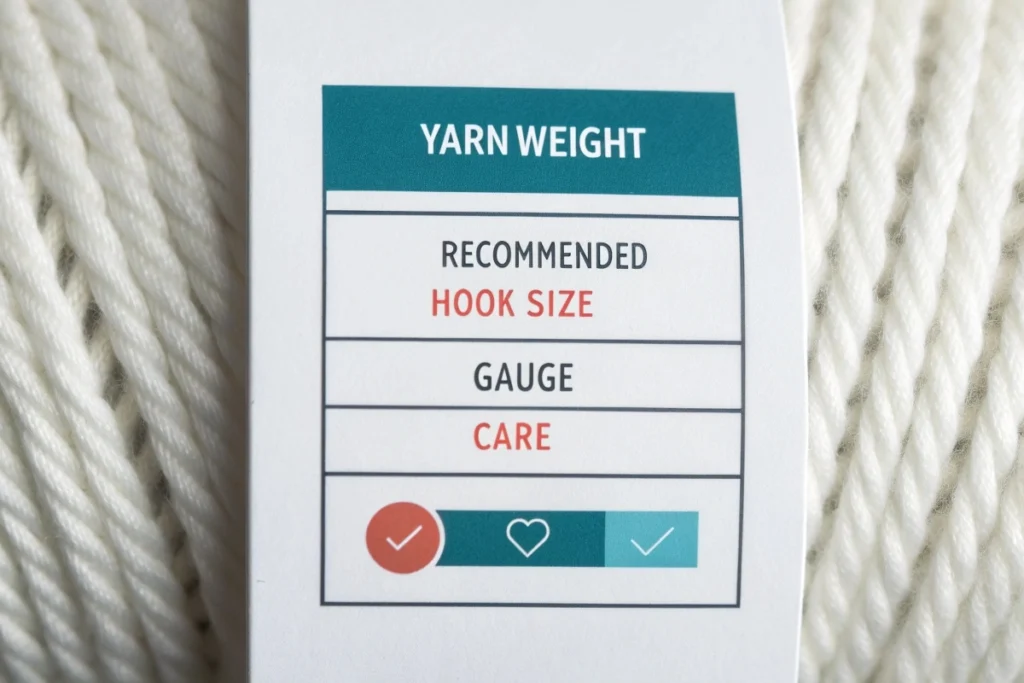
When you’re shopping for yarn—especially as a beginner—understanding the yarn label is just as important as choosing the right color. These labels contain all the key information needed to match your yarn weight gauge hook size correctly.
Reading a yarn label might seem overwhelming at first, but it’s actually a handy guide that helps you avoid mistakes and select the best yarn for your project.
🔍 What You’ll Find on a Yarn Label:
- Yarn Weight Symbol: Usually shown as a number inside a yarn ball icon (e.g., 3 = Light, 4 = Medium/Worsted).
- Recommended Hook Size: Displayed in millimeters and often shown next to a tiny hook or needle icon.
- Gauge Info: Look for a square with stitch and row counts—for example, “16 sc x 20 rows = 4×4 in (10×10 cm).”
- Fiber Content: Tells you what the yarn is made of (cotton, acrylic, wool, etc.), which affects softness, stretch, and washability.
- Care Instructions: Important symbols tell you whether it’s machine-washable, safe to iron, or needs special handling.
🧶 Why This Matters:
Using the yarn label correctly ensures your project will match the pattern’s specifications. It also helps you substitute yarns confidently when you can’t find the exact brand used in a tutorial or pattern.
💡 Pro Tip: Always save your yarn labels until your project is finished. You’ll know exactly what materials were used if you need to make adjustments, repairs, or duplicates.
How Yarn Weight, Gauge, and Hook Size Work Together in Practice
Now that you understand the individual roles of yarn weight gauge hook size, it’s time to connect the dots. These three elements form a delicate triangle that determines the success of every crochet project.
When one changes, the others are affected—so learning how they interact is crucial for beginners who want to avoid frustration.
🧶 Let’s break it down:
- Yarn Weight determines the overall thickness of your stitches.
- Gauge is the measurement that keeps your project size accurate.
- Hook Size controls stitch size and tension.
Think of it like baking a cake: yarn is your ingredient, hook size is your pan, and gauge is your final portion size. If any one of them is off, the whole result can be thrown off balance.
📏 Real Example:
Say your pattern calls for a DK (light weight) yarn, with a 4.0 mm hook, and the gauge should be 20 stitches x 22 rows = 4×4 inches.
If you substitute with worsted-weight yarn using the same hook size, your stitches will be too large. Your final piece may be oversized, misshapen, or too loose. On the flip side, if you keep the yarn but switch to a much smaller hook, your stitches will be tight, your gauge will be off, and your work may curl.
This is why testing and adjusting for yarn weight gauge hook size compatibility is not optional—it’s essential for achieving the intended look and size of your project.
💡 Final Reminder:
Always make a gauge swatch, read the yarn label, and trust the hook size recommended in your pattern. If you’re altering any of these, make sure to adjust the others accordingly for harmony.
Beginner Mistakes to Avoid When Matching Yarn Weight, Gauge, and Hook Size
Even experienced crocheters slip up, but as a beginner, knowing what to avoid when dealing with yarn weight, gauge, and hook size can save your time and yarn stash. These three elements work together, and a mistake with one often affects the others. Let’s look at the most common missteps and how to avoid them.
❌ Mistake 1: Ignoring the Yarn Label
Every yarn skein includes valuable information about yarn weight, recommended hook size, and an expected gauge. If you skip reading the label, your project could end up with the wrong size or tension. Matching the yarn label’s guidance helps ensure your yarn weight gauge hook size combination aligns with the pattern requirements.
❌ Mistake 2: Skipping the Gauge Swatch
One of the most critical steps when balancing yarn weight, gauge, and hook size is making a gauge swatch. It may feel like an extra chore, but this small step tells you whether your hook and yarn will achieve the correct stitch count and size. Skipping this step can lead to ill-fitting or misshapen results—especially in garments or amigurumi.
❌ Mistake 3: Using Incompatible Combinations
Choosing a bulky yarn and pairing it with a small hook—or using lace yarn with a jumbo hook—throws off both the gauge and the look of your stitches. The harmony of yarn weight gauge hook size is what gives your project consistency, neatness, and the texture intended by the pattern designer.
❌ Mistake 4: Assuming All Brands Are Equal
Even if two yarns are labeled the same weight, variations between brands can affect your final gauge. That’s why checking your yarn weight gauge hook size with a swatch is always a smart move before starting.
✅ Tips to Avoid These Mistakes:
- Always read and follow the yarn label’s recommendations.
- Test your yarn weight gauge hook size combination with a swatch.
- Adjust the hook size if your stitches are too tight or loose.
- Don’t skip practice rows—your gauge can change with technique.
Final Thoughts: Mastering Yarn Weight, Gauge, and Hook Size as a Beginner
Mastering yarn weight gauge hook size is one of the most essential skills for anyone starting out with crochet. These three factors—yarn weight, gauge, and hook size—form the core of every successful crochet project, and they are completely interconnected.
Whether you’re working on a scarf, sweater, or amigurumi plushie, choosing the right yarn weight gauge hook size combination will determine the look, feel, and size of your final piece. When the trio is balanced, your stitches will be even, your projects will hold their shape, and you’ll avoid the frustration of ripping back hours of work.
🧵 Why it matters:
The wrong yarn weight can make your project too bulky or too flimsy. An incorrect hook size might create overly tight or loose stitches. And if your gauge is off, the entire pattern can fall apart. That’s why understanding yarn weight gauge hook size relationships from the beginning is so powerful—it sets you up for success every time.
🎯 Quick Recap for Beginners:
- Yarn Weight = Thickness of the yarn strand
- Gauge = Stitch count per measured area (usually 4×4″)
- Hook Size = Tool that determines stitch size and tension
Now that you’ve explored how yarn weight gauge hook size works together, you’re equipped to start your next project with confidence. Grab your hook, check your gauge, and enjoy every stitch with the peace of mind that your foundation is solid.
🧶 Ready to Take Your Crochet Skills Further?
Now that you understand yarn weight, gauge, and hook size, you’re ready to dive into more fun and creative projects! 🎉
👉 Check out our beginner-friendly amigurumi guide to start your first cuddly creation today!
🙋♀️ Frequently Asked Questions (FAQ)
Q: What is the relationship between yarn weight, gauge, and hook size?
A: Yarn weight, gauge, and hook size are all interconnected. The thickness of the yarn (yarn weight) affects how many stitches fit in an inch (gauge), and both depend on the size of the crochet hook you use. To achieve the right stitch size and fabric texture, it’s important to use the correct yarn weight gauge hook size combination recommended in your pattern.
Q: How do I know which hook size to use with a certain yarn weight?
A: Most yarn labels include a recommended hook size based on yarn weight. You can also refer to a standard yarn weight gauge hook size chart to find a suitable range. Adjust based on your desired tension or the gauge swatch result.
Q: What happens if I use the wrong hook size for my yarn?
A: Using the wrong hook size can distort your gauge, resulting in a project that’s too tight, too loose, or the wrong size. For best results, always test your gauge with the specified yarn weight gauge hook size combination.
Q: Why is gauge important in crochet?
A: Gauge determines the number of stitches per inch and helps ensure your finished piece matches the pattern’s dimensions. It’s especially important for garments and fitted items. Getting the gauge right requires the correct yarn weight gauge hook size trio.
Q: Can I substitute yarn if I don’t have the exact one listed?
A: Yes, but the substitute yarn should have the same weight and similar fiber content. Always make a gauge swatch to verify that your new yarn weight gauge hook size combination gives the correct results before proceeding.
Q: Why do some charts show different hook sizes for the same yarn weight?
A: Some simplified charts use narrower ranges for ease, but professional standards like the Craft Yarn Council provide broader recommendations based on gauge and tension.

